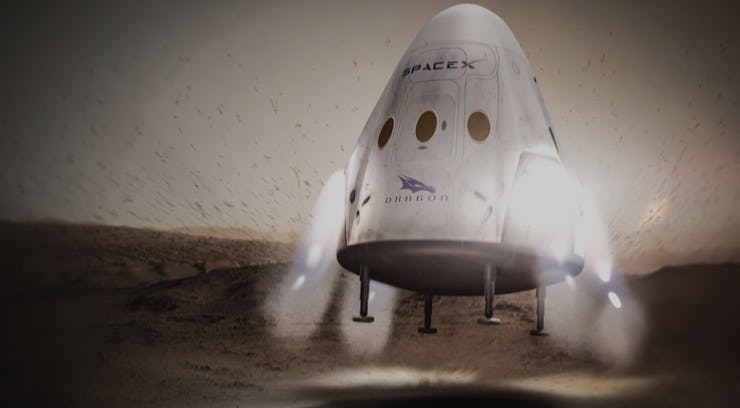Here's Why SpaceX Ditched Propulsive Landings for Dragon Spacecraft
It was a beautiful dream while it lasted.

Elon Musk announced at the International Space Station Research and Development Conference on Wednesday that SpaceX has abandoned its propulsive landing plans for the Dragon spacecraft. When Dragon crafts fly tourists around the moon in 2018 and complete un-crewed missions to Mars in 2020, they’ll do it with a traditional parachute landing instead of using SuperDraco engines to hover down onto the ground (a “propulsive,” or “powered,” landing).
Why did the company decide to nix this idea?
One major reason is that it would be very difficult to design a propulsive landing that would meet safety certifications. Although crafts have previously undergone landings that were either partially propulsive, or totally propulsive but from lower heights (or, in the case of the Apollo 11 Lunar Module, they completely powered landings from orbit — but that was just the lander of the spacecraft), the Dragon’s descent system would have been something new.
“It would have taken a tremendous amount of effort to qualify that for safety, particularly for crew transport,” Musk said in a speech at the conference. “It doesn’t seem like the right way of applying resources right now.”
SpaceX has a lot on its plate right now. The company’s got a dozen more launches planned for this year; it doesn’t have endless time and money to spare on designing a complex new landing apparatus when the traditional system will do.
This test from November 2016 gives an idea of how the propulsion would’ve worked:
Musk also hinted that he has other, better ideas in the works.
“There was a time that I thought the Dragon approach to landing Mars, where you’ve got a base heat shield and side-mounted thrusters, would be the right way to land on Mars,” he said. “Now I’m pretty confident that is not the right way, and there’s a far better approach.”
He noted that this approach will be used by “the next generation of SpaceX rockets and spacecraft,” but he didn’t disclose any further details.
After the interview, Musk tweeted out additional information: He does intend to do propulsive landings on Mars with future SpaceX crafts — just not the Dragon.
“Plan is to do powered landings on Mars for sure, but with a vastly bigger ship,” he wrote. That’s just the kind of cryptic hint on which Musk thrives.
NASA’s position is that propulsive landings are superior to parachute landings for future missions to Mars. Maybe the agency is right, but it’s no longer in the cards for SpaceX in the near future.
Watch Elon Musk’s full speech at the conference below.